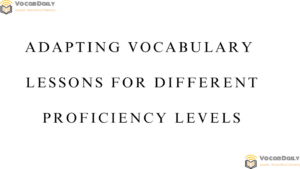Adapting Vocabulary Lessons for Different Proficiency Levels
ESL classrooms often consist of students with varying levels of English proficiency. Adapting vocabulary lessons to meet the needs of all learners is crucial for effective language acquisition. This article explores strategies for differentiating vocabulary instruction to ensure that all students, regardless of their proficiency level, can engage with and benefit from vocabulary lessons.
Vocabulary is a cornerstone of language learning, and its importance cannot be overstated in ESL education. However, the diverse nature of ESL classrooms presents a unique challenge: how to teach vocabulary effectively when students have different levels of English proficiency. Adapting vocabulary lessons to meet the needs of all learners is not just beneficial; it’s essential for creating an inclusive and effective learning environment.
Assessing Student Proficiency
Before adapting vocabulary lessons, it’s crucial to assess the proficiency levels of your students. This can be done through formal assessments, informal observations, or a combination of both. Understanding where each student stands in terms of vocabulary knowledge and overall language proficiency will guide your instructional decisions
.
Tiered Vocabulary Lists
One effective strategy for differentiating vocabulary instruction is to create tiered vocabulary lists. This approach involves categorizing words based on their complexity and relevance to different proficiency levels:
- Tier 1: Basic, high-frequency words that most native speakers know
- Tier 2: Academic vocabulary that appears across content areas
- Tier 3: Subject-specific, low-frequency words
By organizing vocabulary in this way, you can ensure that all students are learning words appropriate to their level while still being exposed to more advanced vocabulary
.
Varied Instructional Techniques
Employing a variety of instructional techniques can help address the needs of students at different proficiency levels. For beginners, focus on concrete vocabulary and use plenty of visual aids, realia, and TPR (Total Physical Response) activities. Intermediate learners can benefit from context clues and word-building exercises, while advanced students can engage with more abstract vocabulary and complex word relationships
.
Flexible Grouping
Implement flexible grouping strategies to allow students to work at their appropriate level. This might involve:
- Homogeneous grouping for targeted instruction
- Heterogeneous grouping for peer teaching and collaborative learning
- Individual work for personalized practice
By varying group compositions, you can ensure that all students have opportunities to both challenge themselves and experience success
.
Scaffolded Activities
Provide scaffolded activities that allow students to engage with vocabulary at their own level. For example:
- Beginner: Matching words to pictures or definitions
- Intermediate: Completing sentences with target vocabulary
- Advanced: Using vocabulary in original sentences or short paragraphs
This approach allows all students to work with the same set of words but at different levels of complexity
.
Technology Integration
Leverage technology to provide personalized vocabulary practice. Many digital tools allow for adaptive learning, automatically adjusting the difficulty level based on student performance. This can be particularly useful for independent practice and homework assignments
.
Cultural Relevance
Ensure that vocabulary lessons are culturally relevant and meaningful to all students. This might involve incorporating words from students’ native languages or selecting vocabulary themes that resonate with their diverse backgrounds and experiences
.
By implementing these strategies, ESL teachers can create vocabulary lessons that are accessible and engaging for students at all proficiency levels. Remember that differentiation is an ongoing process that requires flexibility and responsiveness to student needs.
For more resources on adapting vocabulary lessons for different proficiency levels, visit www.https://vocabdailyofficial.blogspot.com/. Additionally, explore our comprehensive vocabulary workbook designed to support learners at various proficiency levels, available at https://shorturl.at/0a0Qc.


Leave a Reply